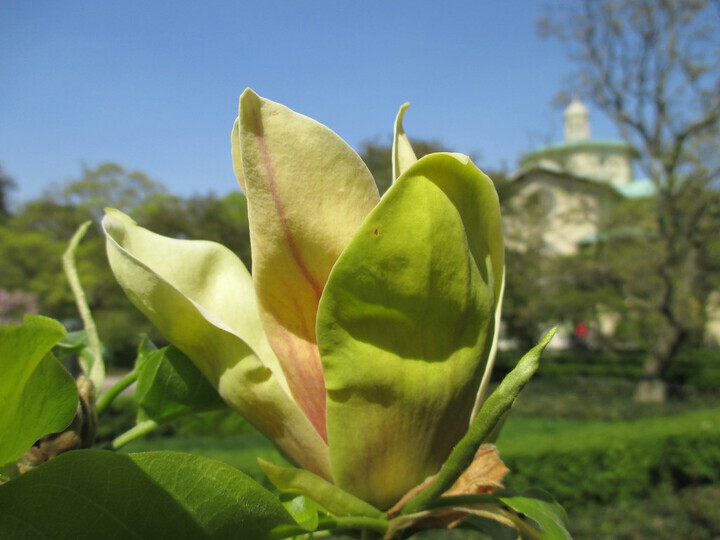Despite the unusually late snowstorm and cold snap, most of Brooklyn Botanic Garden’s cherries are in pretty good shape right now. Some of the early-blooming magnolias suffered, but most of that collection’s blooms are still safely in their bud cases. Time will tell how extreme weather like this might affect plants long term.
“Only three cherry trees were in bloom when the storm came, and those lost about half their flowers. But even those still have some buds that will blossom,” says Brian Funk, curator of the Japanese Hill-and-Pond Garden and Cherry Walk.

The cherries in bloom were the earliest-blooming cultivars. Most of BBG’s collection of more than 200 trees blooms later. There are 26 different ornamental cherry cultivars and species in the Garden. Prunus ‘Okame’ usually signals the start of the spring season with blossoms in late March, and the rest of the collection blooms in succession over the next month. The P. ‘Kanzan’ blossoms along Cherry Esplanade and Cherry Walk provide the finale.
“The buds of a few of the ‘Okame’ had started to swell, so there could be some slight damage, but there are still plenty of flowers left. For the rest of the collection, most buds were still tight. The ‘Kanzan’ and other later-blooming cherries should be perfectly fine as long as the weather stays stable,” says Funk.
The ongoing cold will likely keep further blooms on hold, but once the temperature starts to rise, they will pick up where they left off. The cherries, and many other plants, had already started responding to an unusually warm February. “We’re still likely to see an early peak bloom, because they already got a head start,” says Funk.

Magnolias, in general, start to bloom a bit earlier than the cherries. The collection blooms from mid- to late March through April and into June. Several of the earliest-blooming species had already broken out of dormancy and started blooming when the storm and subfreezing temperatures hit.
“The star magnolias, some of the saucers, and the 'Leonard Messel' magnolias were damaged—maybe up to a tenth of the buds on some trees,” says Wayken Shaw, curator of Magnolia Plaza and Lily Pool Terrace. “The unopened buds on those trees definitely show signs of stress too, particularly the saucers. You can see a different coloration in the buds, with the darker ones desiccated when cut open,” says Shaw.
But the buds of the later-blooming magnolias were still tightly contained inside their bud cases. “Our native magnolias are safer since they bloom much later in May and early June,” says Shaw. “Since the majority of our BBG hybrids are bred with Magnolia acuminata, those specimens should be much better off since they bloom later than their Asian counterparts.” Most bulbs are adapted to early-spring weather fluctuations and should also be fine.

Still, this year’s weather whiplash was highly unusual, so it’s somewhat hard to predict the effects. “An extreme hot-cold winter like this will stress flowering trees, but how they bounce back in the short and long terms depends on the overall health of the plant. If it’s battling disease or, say, the effects of our last two seasons of drought, it will have fewer resources to deal with additional stresses,” says Shaw.
In many plants, some of the consequences might not appear until later. Several peonies, for instance, had started to leaf out prematurely in response to the late-winter warm spell. “They had buds the size of dimes…it doesn’t look good for them,” says Funk.
And though the Garden is a cultivated space, it still functions as an ecosystem, with a variety of interrelated factors affecting the plants and animals that live here. Some are more obvious, and immediate, than others.
More: What Are Pussy Willows Anyway?
Early bloom times and other changes in plant life cycles can have an impact on insects and other wildlife that feed on them and pollinate them, as well as on potential pests—or their natural predators. “For whatever reason, it seems like pathogenic insects always seem to adapt better than beneficial ones,” says Chris Roddick, foreman of the grounds. “If you look at the big picture, new weather patterns throw off natural phenological cycles. We don’t really know how this will play out when it happens year after year,” says Roddick.